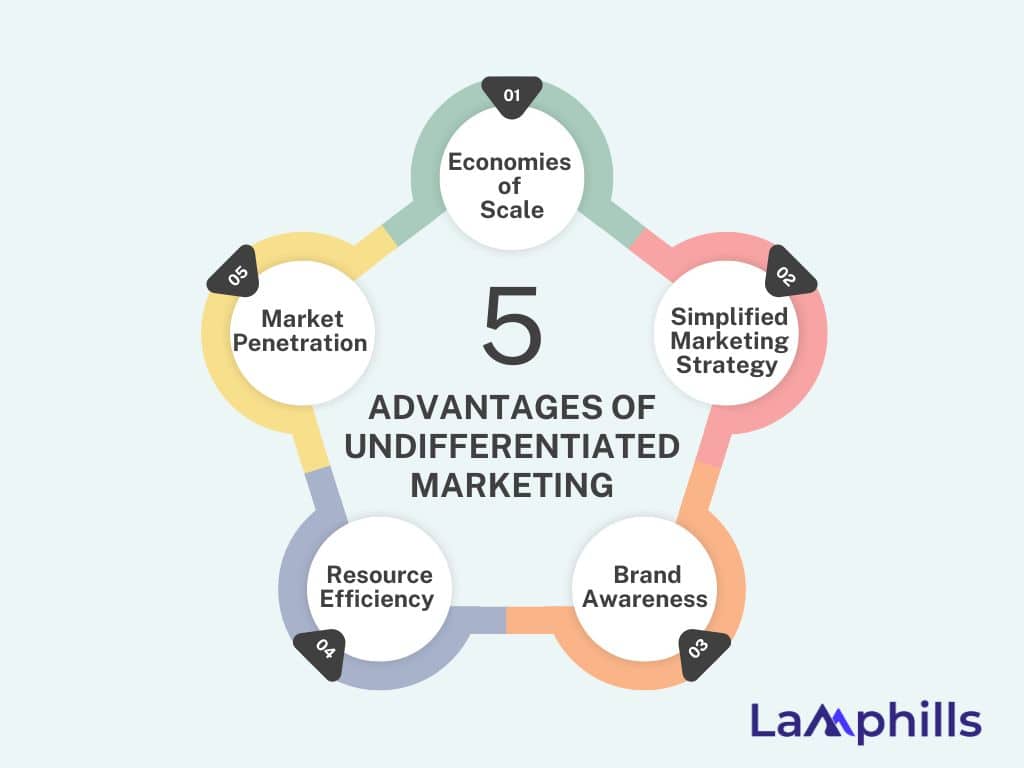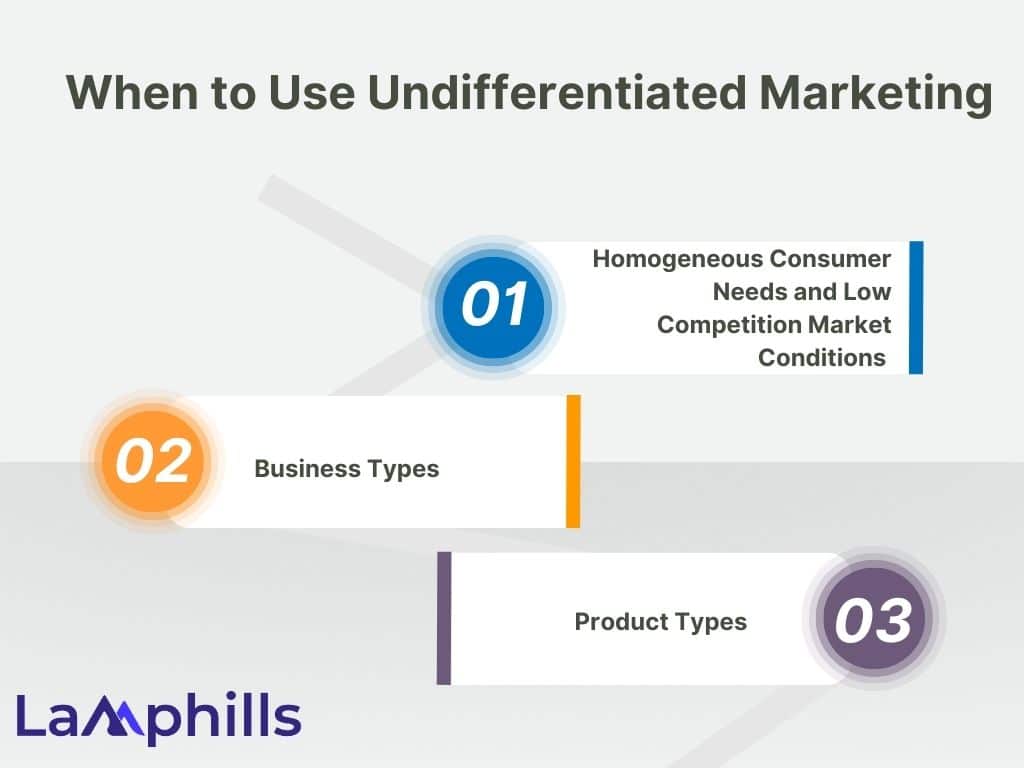Businesses constantly seek effective strategies to reach their audience, increase sales, and achieve other business goals. One common strategy you’ll often hear about is defining your audience and creating targeted marketing campaigns. But what if treating the market as one large audience is best? This approach is known as undifferentiated marketing. Niche marketing is not suitable for all products and services. A company can ignore market segment differences and appeal to the entire market with a single offer or strategy. The Harvard Business Review states that undifferentiated marketing campaigns can reduce marketing costs by 10-15% due to simplified messaging and a reduced need for segmentation.
Today, my job is to help you understand the advantages and disadvantages of undifferentiated marketing. Together, we’ll analyze its drawbacks and benefits, such as economies of scale and trends in a digital economy. Who knows, this might just be what you need to record massive sales. Let’s get started!
Key Points
- Undifferentiated marketing means creating one message for the entire market instead of tailoring messages to specific groups. This strategy focuses on what consumers have in common, aiming to reach the broadest audience possible.
- The Harvard Business Review states that undifferentiated marketing campaigns can reduce marketing costs by 10-15% due to simplified messaging and a reduced need for segmentation.
- It’s also known as mass marketing and has various advantages; however, it doesn’t apply to every business.
- Coca-Cola, Pepsico, McDonald’s, General Electric, and so on are some companies that use undifferentiated marketing.
- This strategy works best in markets with homogenous consumer needs and low competition.
Understanding Undifferentiated Marketing Strategy
Undifferentiated marketing means creating one message for the entire market. Instead of tailoring messages to specific groups, this strategy focuses on what consumers have in common, aiming to reach the broadest audience possible. While this can be effective for some products, it has its challenges.
Unlike differentiated marketing, which targets specific segments with customized messages, undifferentiated marketing uses a one-size-fits-all strategy. It contrasts with concentrated marketing, which intensely focuses on a particular niche. Historically, undifferentiated marketing was popular in the early 20th century, coinciding with the rise of mass production and mass communication. Companies like Coca-Cola and Ford have leveraged this strategy to build global brands.
Advantages of Undifferentiated Marketing

Having understood what undifferentiated marketing is, let’s take a look at some of its advantages:
#1. Economies of Scale
In my experience, one of the most significant advantages of undifferentiated marketing is the ability to achieve substantial cost savings. Businesses have thrown all their caution to the wind when it comes to marketing, forgetting about cost efficiency. The truth is that “a single marketing campaign can be beneficial to some companies.” It reduces per-unit costs and minimizes advertising expenses.
#2. Simplified Marketing Strategy
Undifferentiated marketing simplifies the advertising process. It allows for more consistent messaging and enhances the brand’s identity. Marketers don’t say this often, but managing multiple campaigns for different market segments can be complex and resource-intensive. However, you must remember that it doesn’t apply to every business.
#3. Brand Awareness
A broad marketing approach can significantly enhance brand recognition. Repeating the same message across various channels reinforces brand recall among a wide audience. When Coca-Cola launched its “Share a Coke” campaign, its universal appeal and consistent messaging played a crucial role in strengthening its brand presence worldwide.
#4. Resource Efficiency
Undifferentiated marketing is resource-efficient, especially for large-scale operations. It reduces the need for extensive market research and segmentation analysis. This free resource is for other critical business activities. This efficiency can be a game-changer for companies operating in competitive markets.
#5. Market Penetration
This strategy facilitates rapid market penetration. By targeting everyone with the same offer, companies can quickly build a large customer base, particularly if the product meets a universal need. For instance, when Ford introduced the Model T, its undifferentiated marketing approach helped it become the first affordable automobile for the masses.
Read Also: MARKETING VS ADVERTISING: Differences
Disadvantages of Undifferentiated Marketing
We’ve seen the diverse benefits of differentiated marketing, now, let’s consider some of its drawbacks:
#1. Market Competition
Competing with brands that employ more targeted approaches can be challenging. Differentiated and concentrated marketing strategies often create stronger connections with specific segments, making it harder for mass marketing to stand out. For example, General Motors’ Chevrolet faced difficulties when their broad approach diluted its brand message and failed to drive sales.
#2. Lack of Personalization
One major drawback of undifferentiated marketing is the inability to tailor messages to specific audience needs and preferences. This can result in generic marketing that fails to resonate deeply with any particular group. It can also be a significant limitation where personalization reigns. Here’s the deal breaker: if your product appeals to a specific audience, stay clear of mass marketing.
#3. Customer Alienation
Undifferentiated marketing doesn’t address the unique needs of different segments, which can result in customer alienation. This happens when businesses alienate potential customers by generalizing. These customers may feel overlooked or undervalued. Unfortunately, this can lead to decreased customer loyalty and lower overall engagement with the brand.
#4. Changing Market Dynamics
As consumer preferences evolve, a one-size-fits-all strategy can quickly become outdated. Companies must continuously monitor and adapt to changing market dynamics to remain relevant. This can be challenging with a broad approach. Moreover, staying relevant in an evolving market requires flexibility, a feature that undifferentiated marketing doesn’t have.
#5. Inefficiency in Diverse Markets
Mass marketing can be inefficient in markets with diversity in consumer preferences and behaviors. It may lead to wasted resources for uninterested audiences. This will ultimately reduce the overall effectiveness of the marketing efforts.
Read Also: Integrated Marketing Communication: 5-Step Guide for Integrating Marketing Communication Across Channels
When to Use Undifferentiated Marketing

Undifferentiated marketing has various advantages, however, it doesn’t apply to every business. So before you rush off to initiate this strategy, assess its suitability for your business. If it’s suitable, you’re good to go; if it’s not, please stick to what works for your brand. Under the following circumstances, you can adopt this strategy:
#1. Homogenous Consumer Needs and Low Competition Market Conditions
Undifferentiated marketing works best in markets with homogenous consumer needs and low competition. Mass marketing is perfect when there’s a universal demand for any product. For instance, basic commodities like toothpaste or soap are well-suited for this strategy.
#2. Business Types
The strategy is perfect if the business is a large corporation with well-established brands and resources to support mass production and distribution. Industries like fast-moving consumer goods (FMCG) often use undifferentiated marketing due to the broad appeal of their products.
#3. Product Types
Products with broad appeal, such as basic commodities and everyday essentials, are ideal candidates. These include items like toothpaste, soap, and snack foods. Each of these has a universal demand.
Example of Successful Undifferentiated Marketing
Let’s take a look at some of the brands that successfully used this strategy for their marketing campaigns:
#1. Ford’s Model T
Ford’s use of undifferentiated marketing for the Model T, made it the first affordable automobile for the masses. Henry Ford famously said, “Any customer can have a car painted any color, so long as it is black.” This statement reflects the essence of undifferentiated marketing—offering a single product with minimal variations to the entire market. The strategy leveraged economies of scale, which resulted in reduced production costs and a simplified marketing approach. This ultimately led to the widespread adoption of the Model T.
#2. Coca-Cola
Coca-Cola has historically used undifferentiated marketing to build a global brand. One of the most iconic campaigns is “Share a Coke.” This campaign printed popular names on Coca-Cola bottles, creating a universal appeal. Despite the personal touch of having names on bottles, the core marketing message remained consistent worldwide: Coca-Cola is a refreshing drink to be shared and enjoyed by everyone. This broad approach helped enhance brand recognition and connect with a diverse audience on a global scale.
#3. Colgate
Colgate uses undifferentiated marketing for its flagship toothpaste products. The brand’s messaging focuses on universal dental health benefits that appeal to all consumers. Their campaigns highlight cavity protection, fresh breath, and overall dental hygiene, and are designed to reach a broad audience. This strategy has solidified Colgate’s position as a trusted brand in oral care worldwide.
#4. McDonald’s
McDonald’s often uses undifferentiated marketing to promote its brand and core menu items. The focus is on a broad, universal appeal. Their campaigns like “I’m Lovin’ It” and promotions for staple menu items like the Big Mac or Happy Meals target a wide demographic without significant differentiation. This approach has helped McDonald’s become a global fast-food leader, appealing to diverse age groups and cultural backgrounds.
#5. PepsiCo
PepsiCo often employs undifferentiated marketing for its flagship beverage, Pepsi. The brand focuses on broad, inclusive messaging to reach a wide audience. They mostly use campaigns like “Pepsi Generation” and global promotions during events like the Super Bowl to create widespread appeal. This strategy has enabled Pepsi to maintain strong brand recognition and compete with other beverage giants globally.
#6. General Electric (GE)
GE used undifferentiated marketing to promote its wide range of household appliances. The focus was on reliability, innovation, and quality, targeting a broad audience. Ads for products like refrigerators, washing machines, and light bulbs were designed to appeal to the general public’s need for efficient household solutions. This broad approach helped GE become a household name and a leading brand in home appliances
Differentiated vs Undifferentiated Marketing
Undifferentiated and differentiated marketing strategies have unique advantages and drawbacks. Differentiated marketing allows for tailored messages that drive higher engagement and customer satisfaction but at a higher cost and complexity. On the other hand, undifferentiated marketing doesn’t have the personalization needed to resonate with a specific audience but offers simplicity and cost efficiency.
As a marketer with firsthand experience in both strategies, I recommend carefully evaluating your market conditions, business goals, and available resources before deciding which approach to adopt. Sometimes, a balanced combination of both strategies can offer the best results. Back to differentiated vs undifferentiated marketing, let’s compare them below:
#1. Market Reach
Market reach refers to the number of unique individuals or households exposed to a marketing message within a given period. It indicates the breadth of a campaign’s audience. Differentiated marketing has a narrower reach within each segment but can achieve deeper penetration and loyalty within those segments. Undifferentiated marketing has a broader market reach but can’t actively engage with any particular segment.
#2. Targeting
Under targeting, differentiated marketing targets multiple specific segments with distinct campaigns. Segments are often based on demographic, geographic, psychographic, or behavioral characteristics. On the other hand, undifferentiated marketing targets the entire market with a single message. It treats all potential customers as people with the same needs and preferences.
#3. Brand Positioning
Differentiated marketing allows for specific brand positioning tailored to different segments, which can strengthen brand loyalty and customer engagement. On the other hand, undifferentiated marketing positions the brand broadly. It aims for widespread recognition but lacks deep connections with specific customer groups.
#4. Personalization
Differentiated marketing has a high level of personalization. This is because each segment receives a customized marketing message. On the other hand, undifferentiated marketing has a low level of personalization. This is because the same marketing message is delivered to all potential customers.
#5. Complexity
Differentiated marketing deals with more complexity because it coordinates multiple marketing strategies and campaigns. On the other hand, undifferentiated marketing is easier to manage, as it involves a single, unified marketing strategy.
#6. Cost
Differentiated marketing most often incurs higher costs due to the need for multiple campaigns, extensive market research, and product variations. This is in contrast to undifferentiated marketing. Undifferentiated marketing incurs lower costs due to the simplicity of a single campaign and the economies of scale achieved through mass production and distribution.
Read Also: The Ultimate Marketing Toolkit: Essential Tools for Success
Does Coca-Cola Use Undifferentiated Marketing Strategy?
Yes, Coca-Cola is one of the many companies across the globe that uses undifferentiated marketing strategies.
What Companies Use Undifferentiated Marketing?
The following are some of the companies that use undifferentiated marketing:
- Coca-Cola
- Pepsico
- McDonald’s
- General Electric and so on
Undifferentiated Marketing and Digital Marketing Trends
Undifferentiated marketing has evolved significantly with the advent of digital marketing trends. This allows companies to reach broader audiences more effectively and efficiently. The following are some of the diverse ways that undifferentiated marketing has adapted to the digital landscape:
#1. Broader Reach Through Digital Platforms Like Social Media and Search Engines
Platforms like Facebook, Twitter, Instagram, and TikTok allow brands to broadcast their messages to diverse audiences. Companies can use these platforms to run large-scale campaigns that reach millions of people globally. Google AdWords and similar services enable brands to display ads to a broad audience based on general search queries, maximizing visibility.
#2. Programmatic Advertising
Programmatic advertising allows companies to purchase ad space across several websites and platforms. This method ensures that ads reach a broad audience efficiently.
#3. Cost-Effective Advertising
Digital advertising often has lower costs compared to traditional media. This makes it accessible for companies of all sizes to run broad, undifferentiated campaigns.
#4. Use of Data and Analytics
Digital marketing provides access to vast amounts of data and analytics, helping brands understand broad audience behaviors and preferences. This data can be used to refine and optimize mass marketing campaigns. This means that brands can track the performance of their campaigns in real-time. It also allows them to make quick adjustments where necessary.
#5. Enhanced Content Distribution
The potential for content to go viral on social media platforms has given mass marketing a new edge. Viral videos, memes, and challenges can rapidly reach a massive audience without targeting specific segments. Secondly, collaborating with influencers with broad followers helps brands spread their messages widely. Influencers often have diverse audiences, making them ideal for undifferentiated campaigns.
#6. Cross-Platform Campaigns
Digital marketing allows integrated campaigns across multiple platforms (e.g., social media, email, and websites). This integration ensures a consistent message is delivered to a broad audience, enhancing reach and engagement.
Read Also: 15 Best AI in Marketing Examples of 2024 (+ Tips for AI Marketing)
When Should a Company Consider Switching from Undifferentiated to Differentiated Marketing?
Companies should consider switching from undifferentiated marketing to differentiated marketing under the following circumstances:
- Market Saturation: A saturated market leads to targeting specific niches, which can help capture and retain customers.
- Varied Preferences: When customer preferences become more diverse and complex, undifferentiated marketing may fail to resonate.
- Segmented Demand: When different customer segments exhibit distinct buying behaviors and product requirements, a differentiated approach can better address these nuances
- Multiple Products: As a company expands its product line to include various offerings, each product may appeal to different market segments. Differentiated marketing can ensure that each product reaches its intended audience effectively.
- Specialized Products: Specialized products require targeted marketing efforts to highlight unique features and benefits to the appropriate segments.
- Increased Resources: With growth, a company may acquire more resources (budget, personnel, and technology) to support multiple targeted campaigns, making differentiated marketing feasible.
- Competitor Strategies: If competitors use differentiated marketing to capture specific segments, it may be necessary to adopt a similar approach to stay competitive.
- Market Share Erosion: If a company is losing market share to competitors who offer more personalized marketing, shifting to differentiated marketing can help regain lost ground.
- Data Availability: Access to advanced data analytics and customer insights enables more precise segmentation and targeting. This makes differentiated marketing more effective and manageable.
- Marketing Tools: The availability of sophisticated marketing tools (e.g., CRM systems, and marketing automation platforms) can facilitate the implementation of differentiated campaigns.
- Customer Feedback: Direct feedback indicating diverse customer needs and preferences can signal the need for more personalized marketing strategies.
- Market Research: Insights from market research revealing distinct segments with unique characteristics can justify a switch to differentiated marketing.
- Increased Competition
- Expansion Goals
Lamphills’ Checklist to Assessing the Suitability of Undifferentiated Marketing
Download Lamphills’ Checklist to Assessing the Suitability of Undifferentiated Marketing
How Can a Company Measure the Effectiveness of an Undifferentiated Marketing Strategy?
Measuring the effectiveness of an undifferentiated marketing strategy involves a combination of quantitative metrics and qualitative insights. You’ll need tools and methods such as digital analytics, customer feedback, A/B testing, and market research to measure the effectiveness of undifferentiated marketing strategies.
What are the Risks Associated with Undifferentiated Marketing?
The following are some of the risks associated with undifferentiated marketing:
- Lack of Personalization
- Increased Competition
- Inefficiency in Resource Allocation
- Potential for Market Saturation
- Limited Market Insights
- Missed Opportunities for Niche Markets
- Lower Customer Loyalty
What are Some Common Mistakes Companies Make with Undifferentiated Marketing?
The following are some of the common mistakes companies make with undifferentiated marketing:
- Lack of Market Research
- Ignoring Customer Diversity
- Poor Message Crafting
- Overlooking Competitive Analysis
- Inconsistent Branding
- Ineffective Use of Marketing Channels
- Neglecting Customer Feedback
- Overemphasis on Reach Over Engagement
- Insufficient Budget Allocation
- Failure to Monitor and Adapt
Conclusion
Mass marketing can be an effective strategy for reaching a broad audience, but it carries significant risks that can impact a company’s overall success. Understanding these risks and implementing measures to mitigate them, will enable businesses to leverage this strategy. I guess this is where I’ll ask if the mass marketing strategy is suitable for your brand. Let me know in the comment sections.
Related Articles
- Penetration Pricing Strategy: 6 Advantages and Disadvantages of Penetration Pricing Strategy (+ Examples)
- 15 Best AI in Marketing Examples of 2024 (+ Tips for AI Marketing )
- What Marketing Capabilities and Why it is Important for Your Brand Success
- Incorporating Your Brand Narrative Across Marketing Channels: A Practical Guide






